We’re back with the latest entry in our series of Flash breakdowns. This week’s focus is issue #274, the last chapter on the way to the momentous issue #275! Links to additional artwork and research are included throughout this post.
UP TO SPEED: Last week, Flash attempted to unravel the mysterious appearance of a psychic female fan, while dealing with an internal drug smuggling operation at the Central City Police Department in his civilian guise. Iris continued to reach for Barry’s attention, but lost out to a massive prison riot spurred by the controversial Nephron Project!
COVER: Ross Andru and Dick Giordano handle this month’s cover, as with the previous issue. Andru is the editor of the book. Giordano inked the covers for issues 270-273, and both were omnipresent on DC covers at the time. Andru is credited with nearly 50 covers in 1979, while Giordano inked or wholly produced right around 100.
PG. 1: After quelling the prison riot in issue #273, Flash found Dr. Nephron’s guinea pig Clive Yorkin strapped into Nephron’s machine. Flash does not realize until the next page that Yorkin is actually “treating” himself, using only the “pain” function.
PG. 3 & 4: Flash attempts to assist Yorkin, and gets pounced-on for it. Even so, Flash avoids using super-speed until absolutely necessary, underestimating what exactly the Process has created. Yorkin’s strength and size are enhanced since he began treatments.
PG. 5: Unable to vibrate out of Yorkin’s grip, Flash finds the convict using his speed against him. This issue is a lot heavier on hand-to-hand combat, and less Flash-action or references, but Flash does refer to Yorkin as a “human conductor” capable of “tuning” his body info Flash’s vibrations. Flash’s molecular friction is caused by the voluntary movement of electrons, thus making him a conductor as well, by definition.
PG. 6 & 7 : Yorkin’s prison ID # 4556 does not appear to have any significance. Nephron returns to his lab to survey the damage, but runs into Yorkin, sealing Nephron’s fate.
PG. 8 & 9: Flash discovers Nephron strapped into his own machine, which is set to overload. Flash pulls the plug too late to save the doctor, or his own conscience.
The Process was an interesting psychological aspect of the story, tying into radical behaviorism via pop culture references (outlined last week), and perhaps providing an extreme fable on the price of overindulgence.
PG. 10: The shady character who has been hanging around Police Headquarters recently is revealed as Detective Frank Curtis, undercover narc. The heroin smuggling plot has evolved into almost buddy-cop territory at this point, complete with two Starsky and Hutch references. This issue came out during the summer of 1979, the last year the show aired new episodes. Barry would obviously be Hutch, with Frank as Starsky. This completes the argument for David Soul or Owen Wilson as Barry Allen in The Flash.
When considering potential new Barry Allen stories, fans and analysts have pointed to the popularity of TV shows like CSI and others focused on forensics and crime-lab culture. The notion is not without precedent, and this issue is a prime example of a similar cop-show theme in the Flash title back in 1979.
In fact, today’s CSI cop-shows are so popular that some think TV has begun to influence the way jurors think about evidence.
PG. 11 & 12: From what I can tell, Barry probably would have gotten his degree in police science or a related field and then attended the police academy and gone through all of the basic training.
PG. 13: Barry is just itching to tell someone he’s the Flash.
PG. 14 & 15: This is one of my favorite costume-ring panels of all time.
Artist Alex Saviuk does an amazing job with the super-speed pacing throughout this sequence. The panels below are a great example, the driver doesn’t realize it is Flash until 2/3 of the way through the action.
PG. 17: Melanie, the ESP-powered stalker who briefly gained control over Flash at the end of issue #272, locks in on him again. These are two important panels, showing Barry valuing Iris in an honest moment that is cut short. This physical struggle is representative of the changes going on in Flash at the time, and the sense of inevitability. It appears Bates was working the longtime Flash fans, subtly pulling their heartstrings while the title underwent an overhaul.
LETTERS: Julius Schwartz leaving Flash with issue #269 should have been a big, big deal. Instead, we get one letter complaining about the quality of his last issue and a note from DC saying, basically, “This was the nicest letter we got.”
NEXT ISSUE: “The Last Dance!” Literally!

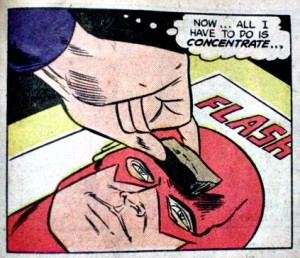
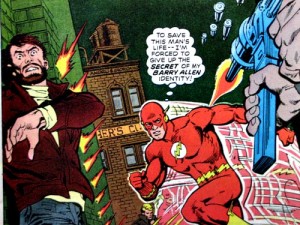
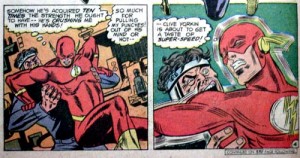
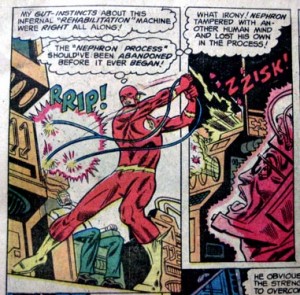
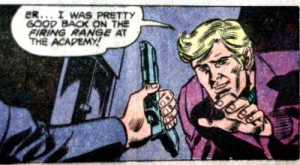
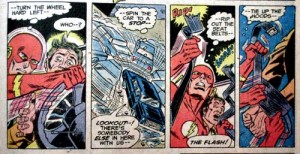
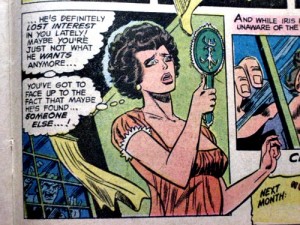
This issue had some great facial expressions, from Yorkin’s crazy-face to Barry’s WTF freakout and goofy grin.
Iris’ new hairdo is awful.